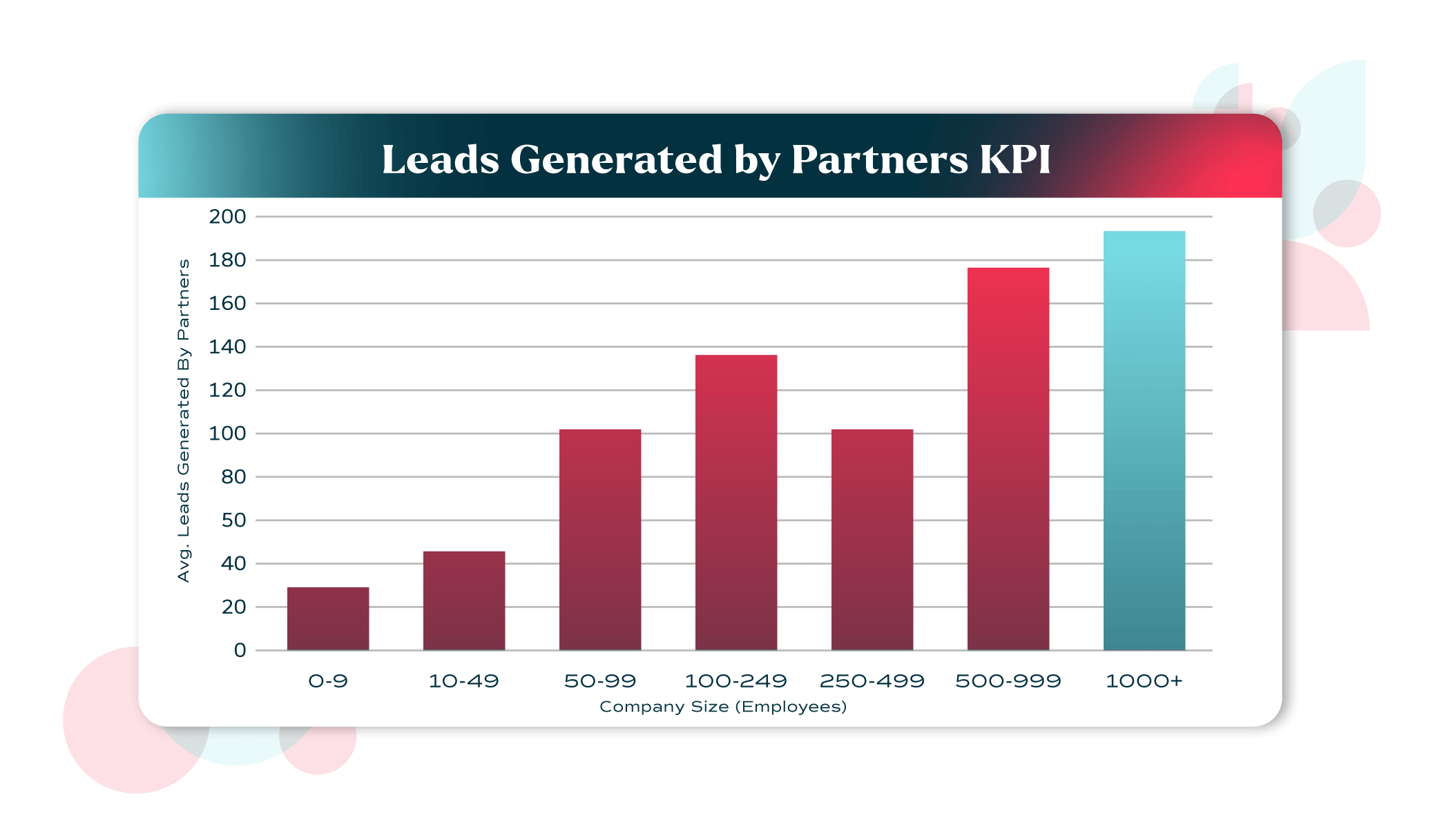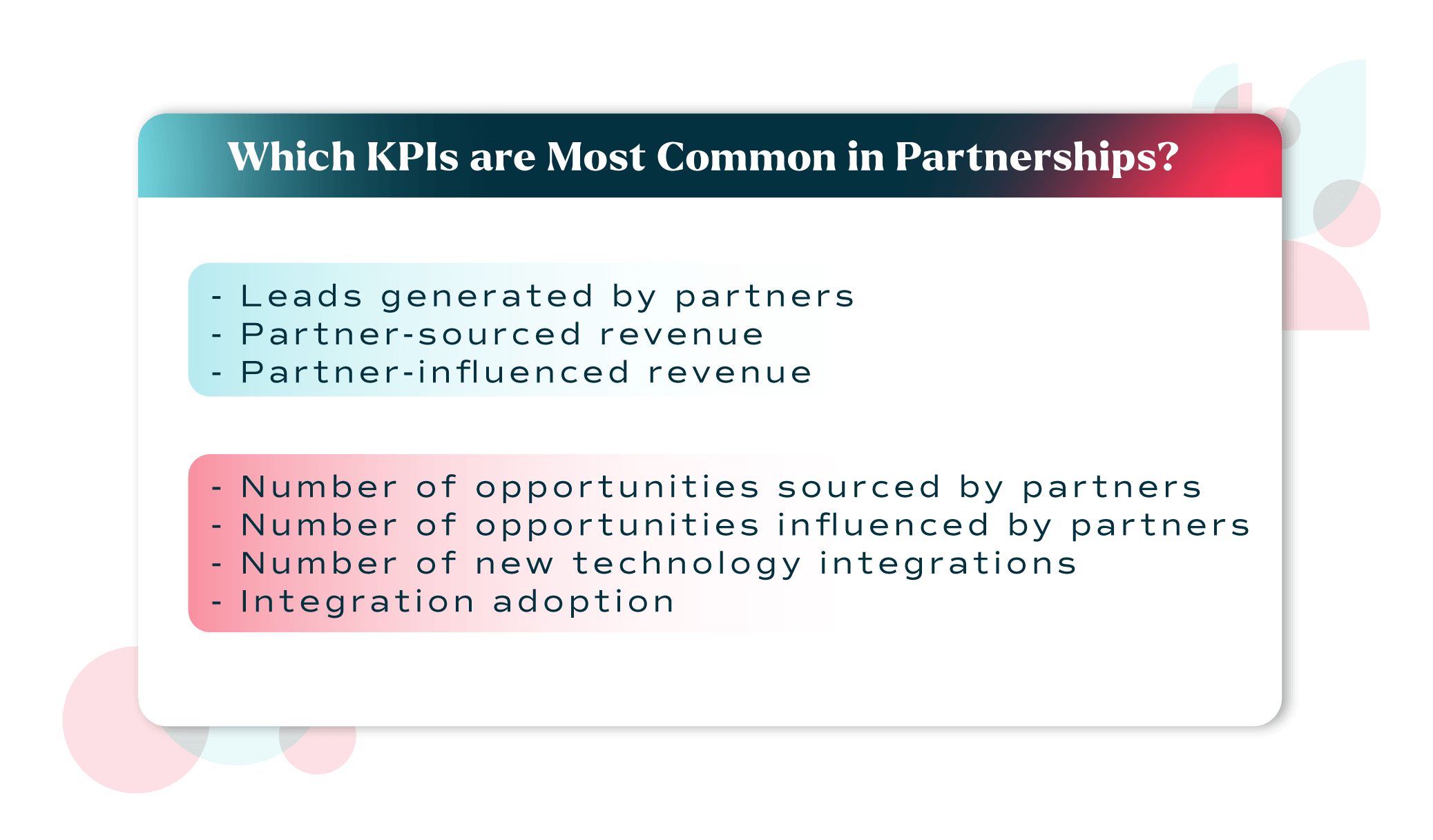Partner-sourced revenue used to be the most common key performance indicator (KPI) for partnership professionals — but, alas, no more. Now, “leads generated by partners” is the most common KPI (but only by a hair). How do we know? Our 2022 State of the Partner Ecosystem Report surveyed 433 partnership professionals to learn exactly which KPIs they’re measured on. The KPIs we asked about:
A Quick KPI Refresh
(If you’re familiar with partnership KPIs, click here to skip this explainer.)
Leads generated by partners (partner-sourced leads)
“Leads generated by partners” are net new leads that are fully generated by partners. They can come from referrals from channel partners, lead swaps with tech partners, demo requests from your partner’s tech marketplace, and more. These leads may or may not become opportunities and turn into partner-sourced revenue.
Partner-sourced revenue (direct attribution)
Partner-sourced revenue is direct revenue from any deal attributed to one or more partners who are 100% responsible for bringing the account into your pipeline. The deal wouldn’t exist without your partner(s). In a channel partnership, this could include the revenue you generate when your channel partner sends you a referral for a net new lead. In a tech partnership, this could include the revenue you generate when leads request a demo through your partner’s tech marketplace.
If the deal closed, the resulting revenue is “partner-sourced revenue”.
Partner-influenced revenue (indirect influence)
Partner-influenced revenue is indirect revenue from any deal attributed partially, but not fully, by one or more partners. Your tech or channel partner may help generate partner-influenced revenue by:
- Making an intro for your sales rep into a target account
- Putting in a good word for your company with their existing account that you’re selling your product into
- Providing your sales rep with context about the account, like which stakeholders have the most buying power, to help accelerate the sales cycle
If the deal closed, the resulting revenue is “partner-influenced revenue”.
Number of opportunities sourced by partners
The “number of opportunities sourced by partners” is the number of qualified opportunities that were generated by an activity by (or with) your partner. (Think of the “number of leads generated” KPI and how many of those leads matured to unique opportunities.)
Number of opportunities influenced by partners
The “number of opportunities influenced by partners” refers to all of the opportunities your partner helped your company qualify. If your partner shared information about a target account’s budget, key stakeholders, and other context to help mature the account to the opportunity stage, that’s a partner-influenced opportunity.
Number of new technology integrations
The “number of new technology integrations” is specifically for tech partner programs. Partnership professionals might prioritize this KPI as they launch their company’s first tech ecosystem. Later, they might grow their tech ecosystem at scale using support from iPaaS solutions, by expanding their API documentation, and/or by building out integrations in new categories and verticals as they expand their integrations team.
Integration Adoption
“Integration adoption” refers to the percentage of users who have adopted one or more integrations. Partnership professionals measure integration adoption in a variety of ways, including:
- The percentage of customers who have adopted a specific number of integrations
- The percentage of customers who have adopted a particular integration
By measuring integration adoption, partnership professionals can uncover additional insights, like:
- How the number of integrations a customer adopts contributes to improvements in customer satisfaction and the longevity of the customer lifecycle
- Which individual integrations contribute to upsells, higher retention rates, and renewals
- Which individual integrations have the most impact on turning free product users into paid customers
The Most (and Least) Common KPIs
According to the 2022 State of the Partner Ecosystem Report, the top three KPIs measured are:
- Leads generated by partners: 60%
- Partner-sourced revenue: 59%
- Partner-influenced revenue: 52%
But how many leads is enough? Of those who get measured on “leads generated by partners”, companies with 50-499 employees are held accountable for between 100-140 leads on average per quarter. This KPI increases to more than 170 leads on average per quarter for companies with more than 500 employees.
Now that you know what your peers are measured on, let’s dig into what the, er, totally uncool KPIs are in the partnerships world.
Partnership professionals are typically not measured on:
- Number of opportunities sourced by partners
- Number of opportunities influenced by partners
- Number of new technology integrations
- Integration adoption
Okay, so they’re not as common, but we actually do think these KPIs are pretty cool. However, the above metrics may not be getting measured because they’re either difficult to track or they’re not as revenue-adjacent.
Attribution is a common challenge for partnership professionals, and metrics like “integration adoption” often translate to more intimidating indicators of success like retention and churn. Understanding the impact your tech ecosystem has on retention and churn requires more long-term analysis, establishing a custom attribution model, and adopting attribution tracking tools — which requires buy-in, which requires proof of success, which requires… 🤯
The lack of respondents tracking integration adoption could also be due to other teams, like customer success and sales, carrying the weight of the integration adoption KPI as they work closely with customers throughout the customer lifecycle.
Compared to other metrics, it’s much easier to track leads generated by partners by using:
- Partner ecosystem platforms (PEPs) like Crossbeam for account mapping to identify mutual prospects and generate EQLs
- Partner relationship management (PRM) tools to track deal registration with channel partners
- Metrics on direct conversions from partners’ tech marketplaces
- Partner-specific accounts in customer relationship management (CRM) tools
Establish the right process and Ecosystem Ops, and the metrics (and buy-in) will follow.
Are Your Peers Hitting Their KPI Goals?
Typically, yes, and this is good news for partnership professionals! Of those who measure “leads generated by partners”, 75% reported that they hit their goals most of the time. Meanwhile, a quarter of partnership professionals don’t hit their goals.
(Check out which KPI goals partnership professionals typically achieve — and more stats — in our 2022 State of the Partner Ecosystem Report.)
Keep in mind: Oftentimes, goals attached to KPIs are stretch goals to help scale your partner program each quarter. Getting as close to the goal as possible is a success.
John Smit, Channel Sales Manager at Introhive, says, “Even if you don’t get deals in for the first three to six months, you have to have those targets you’re working towards.”
Nouras Haddad, Vice President of Alliances at Firebolt says, “Sourced revenue is the goal that we’re working towards. Depending on which goal you set for yourself, that’s going to influence the actions you take. We are working back from, ‘Okay, for us to drive 20% net new revenue a year from now, what do we need to achieve?’ That’s our North Star.”
With the right KPIs in place, you’ll be directly contributing to your company’s revenue growth — whether you technically hit your goals each quarter or not.
–
Turn your ecosystem into your #1 revenue source
Get started in under a minute. Instantly capture insights from your partners. Identify more opportunities. Did we mention it’s free?













